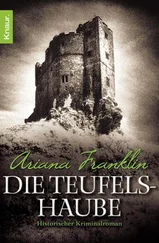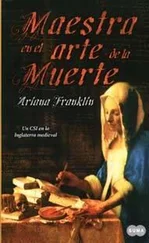A gate in the barge’s taffrail was opened and a gangplank laid across the gap between it and the bank. The captain, a worried-looking man, came aboard.
“How did she get across the river?” Henry asked.
“There was an old wherry further down, my lord. We think Lord Montignard poled her across…my lord, he tried to delay her capture, he fought like a wolf, my lord…he…”
“They killed him,” the queen called from the bank. She was brushing the soldier’s restraining hand off her arm like a speck of dust.
The king went forward to help her aboard. “Eleanor.”
“Henry.”
“I like the disguise, you look well in it.”
She was dressed like a boy, and she did look well in it, though as a disguise it would have fooled nobody; her figure was slim enough, but the muddy, short cloak and boots, the angle of the cap she’d stuffed her hair into, were worn with too much style.
The cheering from the abbey had stopped; there was an openmouthed silence as if people on the far bank were watching a meeting between warring Olympians and waiting for the thunderbolts.
There weren’t any. Adelia, crouched in the stern, watched two people who had known each other too well and been too long together to surprise now; they had conceived eight children and seen one of them die, ruled great countries together, made laws together, put down rebellions together, quarreled, laughed, and loved together, and if, now, all that had ended in a metaphorical attempt to disembowel each other, it was still in their eyes and hung in the air between them.
As if, even now, she couldn’t bear to look anything but feminine for him, Eleanor took off her cap and sent it spinning into the river. It was a mistake; the boy’s costume became grotesque as the long, graying hair of a fifty-year-old woman fell over its shoulders.
Gently, mercifully, her husband took off his cloak and put it around her. “There, my dear.”
“Well, Henry,” she said, “where’s it to be this time? Back to Anjou and Chinon?”
The king shook his head. “I was thinking more of Sarum.”
She tutted. “Oh, not Sarum, Henry, it’s in England.”
“I know, my love, but the trouble with Chinon was that you insisted on escaping from it.”
“But Sarum,” she persisted. “So dull.”
“Well, well, if you’re a good girl, I’ll let you out for Easter and Christmas.” He gestured to the rowers to take up their oars. “For now, though, we’re making for Oxford. Some rebels there are waiting for me to hang them.”
An enraptured Adelia woke up in panic. There was a river between her and her child. “My lord, my lord, let me off first.”
He’d forgotten her. “Oh, very well. ” And to the rowers, “Make for the other bank.”
Against fast running water, the procedure was lengthy, and the king tutted irritably all through it. By the time the barge was settled at a disembarking point on the requisite bank, it had gone long past the abbey, and Adelia was handed ashore on a deserted stretch of meadow into mud that she sank in up to the tops of her boots.
The king liked that. He leaned over the taffrail, humor restored. “You’ll have to squelch back,” he said.
“Yes, my lord. Thank you, my lord.”
The barge took off, its dipping and rising oars sending glittering droplets back onto the surface of the water.
Suddenly, the king was running along the barge’s length to the stern so that he could tell her one more thing. “About the bishop’s oath,” he called, “don’t worry about it. ‘…if You will guard her and keep her safe…’ Very nicely phrased.”
She called back. “Was it?”
“Yes.” The rapidly increasing distance between them was forcing him to shout. “Adelia, you’re my investigator into the dead, like it or not…”
All she could see now was the Plantagenet three-leopard pennant fluttering as the barge rounded a wooded bend, but the king’s voice carried cheerfully over its trees: “You’re never going to be safe.”
Fair Rosamund Clifford holds a bigger place in legend than she does in historical records, which make only brief references to her, and I hope her shade does not haunt me for my fictional portrayal.
The English Register of Godstow Nunnery , edited by Andrew Clarke and published by the Early English Text Society, shows that the abbey was both highly regarded and efficiently administered at this time. It was also broad-minded enough to bury the body of Henry II’s mistress, Rosamund Clifford, in front of the altar, where the tomb became a popular shrine. However, the great bishop, Hugh of Lincoln, though he had been a friend of Henry’s, was shocked to find it there when he visited the convent in 1191, two years after the king’s death, and ordered it to be disinterred and reburied somewhere less sacred in the convent grounds.
Most of the rebellion of Henry II’s family took place on the continent but, since the nice thing for a novel writer is the gap in medieval records, I have dared to interpose one such rising in England, where we do know at least that some of his discontented barons were quick to join in Young Henry and Eleanor’s fight.
Eleanor of Aquitaine survived the death of Henry and the imprisonment he imposed on her. In fact, she survived all her sons as well, except King John. In her seventies, she crossed the Pyrenees to arrange the marriage of a granddaughter, and suffered an abduction and, later, a siege. She died at the age of eighty-two and was laid to rest beside her husband and Richard the First, their son, in the Abbey of Fontevrault, where their effigies are still to be seen in its beautiful church.
I make no apology for the way in which my characters go by water between Godstow and various places. The Thames around the island on which the remains of the convent stand is navigable to a fair way farther up even now, and there is every likelihood that its tributaries have changed their courses over the years, and those of the Cherwell, now disappeared, provided better going than the lesser roads. As Professor W. G. Hoskins, the father of landscape archaeology, says in his Fieldwork to Local History (Faber and Faber), “In medieval and later times a large proportion of inland trade went by river, far more than has ever been generally realised.” Also, there are references to the Thames freezing during the very cold winters of the twelfth century.
Incidentally, beavers were common in English rivers during the twelfth century. It was later, in the 1700s, that they were hunted to extinction for their fur.
And, unlikely as it seems, opium was grown in the East Anglian fens, not only in the twelfth but in succeeding centuries-it is thought that the Romans brought the poppy to England, as they brought so much else. The tincture fen people called “Godfrey’s Cordial”-a mixture of opium and treacle-was still in use in the twentieth century.
One by one, all of Henry’s sons turned against him, and he died at Chinon in 1189, probably from bowel cancer, knowing that his youngest and most loved, John, had joined the rebellion of the elder brother, Richard.
I have given the manor of Wolvercote a fictitious lord for the purposes of this story; the real owner of the manor at this time was a Roger D’Ivri, and I have no evidence that D’Ivri was involved in any rebellion against Henry II, though it is interesting that, whether he wanted to or not, he later gave the manor to the king, who gave it to Godstow Abbey.
The reference to paper as a writing material in chapter four may offend the general view that paper did not reach Europe, certainly northern Europe, until the fourteenth century. Granted, it wasn’t used much in the twelfth century-scribes and monkish writers were snobbish about it and preferred vellum-but it was around, though probably of poor quality. Viz the interesting article posted on the Internet: “Medieval Ink” by David Carvalho.
Читать дальше











